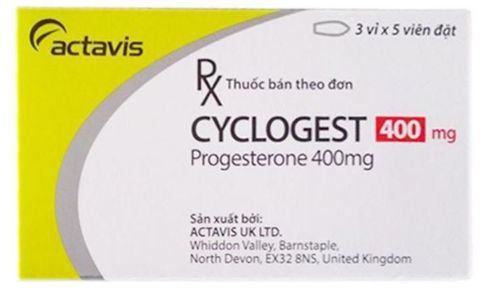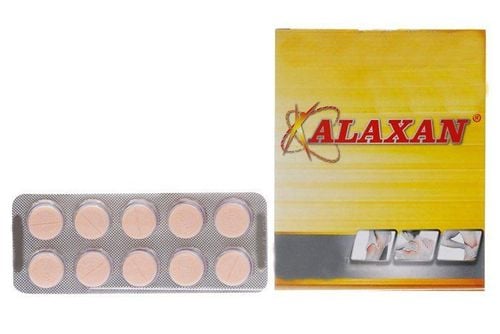This is an automatically translated article.
Paracetamol is a common pain reliever used to treat aches and pains, and also has a very effective antipyretic effect. However, paracetamol is not a strong pain reliever, but still must be used with caution.1. Some notes when taking paracetamol
Active ingredient Paracetamol is not a strong pain reliever, it usually takes at least 1 hour to fully exert its analgesic and antipyretic effect. Accordingly, in order to use paracetamol effectively, patients need to pay attention to the following things:
Do not use many different drugs at the same time but have the same active ingredient paracetamol; Using Paracetamol at the recommended dose instead of high-dose painkillers is safe during pregnancy and while breastfeeding; Brands of drugs with active ingredients of paracetamol include: pain reliever efferalgan 500mg, Disprol, Hedex, Medinol and Panadol; Paracetamol can be taken with or without food; The usual dose of paracetamol for adults is 1 or 2 500mg tablets, up to 4 times in 24 hours (up to 8 500mg tablets in total) in 24 hours. The interval between each use needs at least 4 hours; Taking high doses of pain relievers, including an overdose of paracetamol, can cause serious side effects. Do not increase or double the recommended dose on your own when your pain is very severe;
Paracetamol is widely sold as tablets and capsules. For those who find it difficult to swallow tablets or capsules, paracetamol is also available as a syrup or as effervescent tablets dissolved in water for ease of ingestion; Paracetamol is also available as a suppository (anal injection). Suppositories are useful for pain relief and fever reduction in children who have difficulty swallowing tablets or syrup, or who are seriously ill. MORE: What does Paracetamol do?

paracetamol cũng có sẵn dưới dạng siro rất hữu ích để giảm đau và hạ sốt ở trẻ em
2. Who should consider taking paracetamol for pain relief?
Because it is not a strong pain reliever, most people can safely take paracetamol, including pregnant and nursing women. If you need to use paracetamol during pregnancy or while breastfeeding, use the lowest effective dose of paracetamol and use it for the shortest possible time.
However, some subjects need to be more cautious when using paracetamol. Check with your doctor or pharmacist if you:
Previous allergic reaction to paracetamol or any other medicines; Have liver or kidney abnormalities or diseases; Regularly drinking more than the maximum recommended amount (14 units of alcohol per week); Are taking medication for epilepsy; Currently being treated for pulmonary TB with anti-tuberculosis drugs; Concurrent use of a vitamin K antagonist (warfarin) that thins the blood and requires frequent use of paracetamol; Children can take paracetamol as follows:
Liquid syrup: from 2 months of age; Suppositories: from 2 months of age; Tablets (including soluble tablets): from 6 years old; Do not give paracetamol to children younger than 2 months of age, unless prescribed by a doctor.
| Tuổi của trẻ | Hàm lượng | Số lần dùng thuốc trong ngày |
| 6 - 8 | 250mg | Tối đa 4 lần trong 24 giờ |
| 8 - 10 | 375mg | Tối đa 4 lần trong 24 giờ |
| 10 - 12 | 500mg | Tối đa 4 lần trong 24 giờ |
| 12 - 16 | 750mg | Tối đa 4 lần trong 24 giờ |
Contraindications to using high-dose painkillers with paracetamol:
Lack of calories, malnutrition; Acute liver failure; Hepatitis C; Severe kidney failure; Shock (shock) when the need for blood supply to the organs is reduced; Overdose of acetaminophen.

Chống chỉ định sử dụng thuốc giảm đau liều cao có paracetamol khi bệnh nhân suy thận nặng
3. What to do if you miss a dose of paracetamol
If you take paracetamol regularly and miss a dose, take it as soon as you remember, but skip the missed dose if it is almost time for your next dose. Besides, you also need to be careful not to take a double dose of paracetamol and do not take an extra dose to make up for the missed dose.
If you miss a dose often, you can set a reminder on your smartphone and remind you when it is time to take your medicine. You can also ask your pharmacist for advice on other ways to help you remember to take your medicine.
4. Take paracetamol with other strong pain relievers
It is safe to take adult paracetamol with other pain relievers that do not contain paracetamol, such as ibuprofen, aspirin, and codeine. However, patients should not take paracetamol together with other medicines containing paracetamol.
Ibuprofen is the only safe pain reliever for children along with paracetamol. However, do not give paracetamol and ibuprofen at the same time. You need to give each of these medicines to your child (unless your doctor or nurse tells you otherwise).
MORE: Ibuprofen dosage chart by age, weight of the child
If the patient takes 2 different medicines containing the same active ingredient paracetamol, there is a risk of overdose, so before taking any medicine Please check the label to see if they contain paracetamol.
Some prescription medicines contain paracetamol in combination with other strong painkillers such as:
Co-codamol (paracetamol and codeine) Co-dydramol (paracetamol and dihydrocodeine) Tramacet (paracetamol and tramadol). Because it is not a strong pain reliever, most people can safely take paracetamol. However, to ensure health, patients should read the instructions carefully before using paracetamol and follow the doctor's instructions on the type of drug and dosage for each specific patient.
Please dial HOTLINE for more information or register for an appointment HERE. Download MyVinmec app to make appointments faster and to manage your bookings easily.
Reference source: webmd.com, nhs.uk












